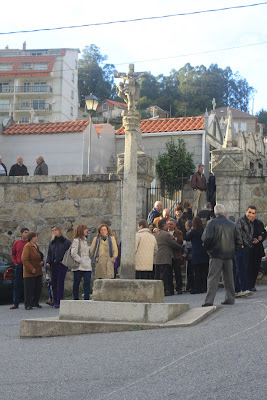First of all, nobody knows what Thanksgiving is. It's a distinctly "New World" holiday, and once the Protestants fled Europe I think most of the folks over here kind of checked out on their status (this was, after all, some time before Facebook). Everything is open, its a workday, and people are going about their business with no excitement over 4-day weekends or special meals or anything.

Secondly, there's the weather. Not that I'm complaining (whatsoever), but it just doesn't feel quite like Thanksgiving when this is the morning view out your window. It touched upper-60s yesterday, with full sun, and we ate lunch with the balcony door open. I will take this over New York Thanksgiving weather for the rest of my life, but like I said, totally different vibe.
Then, there is the food. I'm not naive enough to believe that Thanksgiving dinner in most households is anything like what the Pilgrims ate hundreds of years ago (whenever you take stuffing out of a box something is amiss), but at its heart the meal that is the center of the holiday remains a celebration of (generally) American indigenous, seasonal, and homemade food. In that way, it's a little tricky planning the meal when you are living in a different continent, within a country with a different climate and in a part of which where imported and/or out-of-season foods are rare, hard to find, and often very expensive. Generally, though, I'm very pleased and excited about the meal we are expecting to eat today.
 First and most important for Thanksgiving dinner, there is the turkey: turkey is rare in Spain (particularly whole turkeys), but fortunately we were able to specially order one from the local supermarket, which came fresh yesterday--and I mean FRESH. It still had some stray feathers all around the feet! The turkeys here (like everything in Spain) are smaller than the ones in the United States (ours was just over 6 kilos, around 13.5 pounds), and a bit more expensive (ours was somewhere around $3.69 per kilo, more or less $1.67 per pound...if memory serves, that's about twice what the standard bird costs back home). Even at its small size, it still barely fit into our tiny oven. I'm hoping the cooking conditions are suitable for a bird this size, because I have very high hopes for this turkey: judging by how fresh it appears to be, it's small (read: normal & healthy) size, and it's (for Spain's standards) very high cost, I'm thinking this is a free-range, organic bird that probably bears a lot of similarities to so-called "heritage turkeys" that go for around $150 in the States. At least, that's what I'm convincing myself.
First and most important for Thanksgiving dinner, there is the turkey: turkey is rare in Spain (particularly whole turkeys), but fortunately we were able to specially order one from the local supermarket, which came fresh yesterday--and I mean FRESH. It still had some stray feathers all around the feet! The turkeys here (like everything in Spain) are smaller than the ones in the United States (ours was just over 6 kilos, around 13.5 pounds), and a bit more expensive (ours was somewhere around $3.69 per kilo, more or less $1.67 per pound...if memory serves, that's about twice what the standard bird costs back home). Even at its small size, it still barely fit into our tiny oven. I'm hoping the cooking conditions are suitable for a bird this size, because I have very high hopes for this turkey: judging by how fresh it appears to be, it's small (read: normal & healthy) size, and it's (for Spain's standards) very high cost, I'm thinking this is a free-range, organic bird that probably bears a lot of similarities to so-called "heritage turkeys" that go for around $150 in the States. At least, that's what I'm convincing myself.For sides, we'll be preparing mashed potatoes, broccoli au gratin, homemade chorizo stuffing, and corn. Cranberry and such are harder to find, but since neither Emily nor I are big fans, we didn't search very hard and decided to leave it off the menu. For my part, I most miss in-season apple cider.
For desserts we've prepared homemade macaroons with chocolate ganache, and Emily's homemade apple pie a la mode.


































